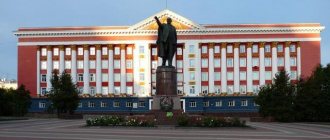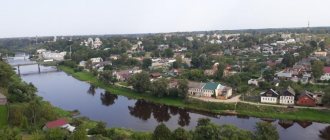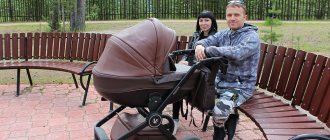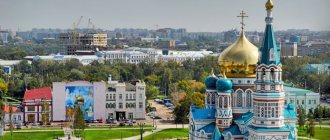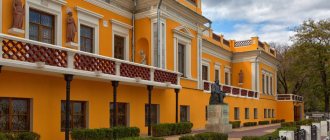The city of Mednogorsk is located 224 km southeast of Orenburg in the valley of the Blyava River (Ural basin). Founded in 1934 in connection with the development of the Blavinsky copper-pyrite deposit and the construction of the Mednogorsk copper-sulfur plant (now the leading enterprise of the city).
But the origins of Mednogorsk go further... On January 1, 1915, the first and only tunnel was inaugurated on the Orenburg-Orsk railway line. The construction of a track began further to the east. At the same time, a trackman's booth was erected approximately on the site of the current station. Later, siding No. 10 was built in front of the tunnel entrance.
In 1929, a large geological exploration expedition settled in Orsk. A search party led by Azerbaijani mining engineer Mamed Osman-ogly Mamedov worked on the banks of the Blyava River. He was an interesting person - a participant in the civil war, a former military attache of the USSR in Turkey, a graduate of mining and industrial academies.
The very first wells encountered red iron ore. The thickness of the formation was small. Mamedov received an order: to liquidate the geological exploration group. But he believed that the search must be continued. He shared his thoughts with the famous geologist Professor Nikolai Konstantinovich Razumovsky. He immediately responded with a telegram: “If you dig deeper, then under the iron hat you will stumble upon copper ore.” Mamedov was also supported by the chief engineer of the Orsko-Khalilovsky geological base, Joseph Leontievich Rudnitsky.
Mamedov and the workers continued drilling. And here is victory! Having passed through a layer of red iron ores, we came across a layer of pyrites. The elder of Orenburg geologists I.L. Rudnitsky wrote: “The thickness of the Blyavin iron hat reaches 35 meters. Below is the main rock of pyrites, which contains copper, gold and other valuable metals.”
The whole country started talking about the Blavinskoye field. After a detailed study, it became clear that we are talking about a large deposit of sulfide ores, shaped like a lens. Its thickness reached 200 meters.
The lands of the Ovtsevod state farm, located in the village of Usergen, were allocated for the construction of the mine and plant. Experienced engineer Bronislav Yuryevich Kudish was appointed head of construction, and Evgeny Fedorovich Kozhevnikov (later Minister of Transport Construction of the USSR) was appointed chief engineer. The construction department was located in the village of Blyava.
Construction got off to a difficult start - almost all excavation work was done by hand. There was only one steam shovel for the entire site. The dormitory barracks were incredibly crowded.
In February 1934, an electric locomotive transported the first set of trolleys with ore from the adit - the Blavinsky mine produced its first products for testing. A year later, in April 1935, regular shipments of ore to Karabash and other copper smelters in the Urals began.
On May 30, 1936, a ceremonial meeting was held dedicated to the laying of the main building of the copper-chemical plant, the construction of which began six kilometers from the mine.
On those same days, in the village of Nikitino, so named in memory of the first party organizer of the construction project, Nikolai Markovich Nikitin, who died in a car accident, a pilot plant began operating - a smaller copy of the future plant. The technology for processing Blavinsky ores was developed.
Until then, factories that processed sulfate ores emitted thousands of cubic meters of sulfur dioxide gases into the air. And now the gas, which was obtained in water-jacket furnaces during the smelting of ore, was sucked out and, having passed through a system of apparatus, turned into a brown liquid, which poured out of the pipeline into the warehouse and, solidifying, was transformed into bright yellow crystals. At the end of 1938, the first tons of domestic gas sulfur were produced at the pilot plant. The first train with a completely new product for the Orenburg region, obtained from gas, left the access tracks.
When Academician A.E. Fersman visited the Blavinsky plant and got acquainted with a new method of using sulfur dioxide gases; he admitted that this method “is making a profound revolution not only in the economics of using pyrite deposits, but also in the entire sulfur business. Its economic importance is enormous.”
A lot of effort was spent until the pilot plant produced the first sulfur and matte - an intermediate product from which copper is obtained. How many experiences did the engineers have, and the first forge operator Fyodor Rodionovich Chekopasov, and his young assistants - yesterday's construction workers, and the first director of the plant, Vladimir Nikolaevich Osiev, in those difficult days when the furnace was blown out several times, and it went out. The “goat” had to be smashed with sledgehammers, the blocks had to be pulled out of the oven and started all over again.
“When the hole was punched for the first time and splashes of metal flew everywhere,” one of the first builders of the city, then the most experienced forge worker, senior foreman of the metallurgical workshop, Hero of Socialist Labor, deputy of the City Council Ivan Tikhonovich Matvienko, recalled about those days, “we rushed out of fear.” scattered. All the guys are rural, they have never seen anything like this in their lives. Fyodor Rodionovich gathered us, patiently explained, and showed us how to work with a screw. “Everything must be done boldly!” - I will remember his words for the rest of my life...
The production of sulfur, and later sulfuric acid, on a large scale was organized at the Mednogorsk copper-sulfur plant, which became the first enterprise in the Soviet Union (and the second in the world) to produce both copper and sulfur simultaneously.
Along with the plant, villages grew near the Medny, Nikitino, and Rakityanka crossings. On April 8, 1939, the Presidium of the Supreme Soviet of the RSFSR adopted the Decree: “The villages of the Medny crossing of the Kuvandyk district ... to be transformed into the city of Mednogorsk.” In the same year, the first three copper smelting furnaces began operating at the plant.
Over the years, the plant expanded, gained strength, and developed new products. Sulfur, blister copper with gold and silver, sulfuric acid, and blister lead began to be shipped to consumers. At the same time, the quarry of the Belyavinsky mine was being developed, where ore was mined using an open pit method. Nowadays the huge bowl of the quarry, up to 180 m deep, is an impressive sight. Over time, ore reserves began to dry up, and the metallurgical shop received ore from the Gaisky mining and processing plant. Nowadays, the hydrometallurgical method of copper mining is also successfully used.
In June 1941, the first groups of Mednogorsk residents went into the active army to defend their homeland. And a few months later, trains with equipment from the Tula defense plant evacuated to the Urals began to unload on the access roads of the copper-sulfur plant. This oldest enterprise, founded under Peter I, was destined to settle in the village of Nikitino. The stone box of the briquette factory of the copper-sulfur plant under construction became the main building of the new plant. The plant's garage was used for one of its workshops. Some of the machines worked under light temporary shelters or even in the open air. Engineering services were housed in cubicles, sheds, and old railroad cars. The winter of 1941-42 was unusually harsh. There was no time to install steam heating in many rooms. It was forbidden to touch metal with bare hands. It was especially difficult to endure the cold with meager military rations.
Housing was also incredibly difficult. People were placed wherever possible - in Nikitino and Rakityanka, in the city and at Blyava station, and even in Rysayevo and Kuvandyk. Trains delivered workers to their shifts, but due to drifts, they were sometimes unable to get through to Mednogorsk. Therefore, many spent the night at the plant - under steam heating radiators, on tables, where it was warmer.
It was very difficult, but despite everything, already in December 1941 the plant began producing products for the front, and in March 1942 it reached the planned production volume.
In those days, both the copper and sulfur plant and other enterprises of the city operated under wartime regime. As reported in a memo to the USSR State Planning Committee in September 1943: “The industry of the city of Mednogorsk, accounting for about 20 percent of the entire industry of the region and representing the production of copper and sulfur, has increased 8 times.”
In 1945, the Tula plant quickly converted to producing civilian products; on its basis, the Uralets electric motors, magnetic starters, and electric vacuum cleaners were built.
Simultaneously with industrial construction, the city itself grew. There are many beautiful buildings built in it - the Palace of Metallurgists, the House of Culture of Miners. House of Soviets, House of Culture for Mechanical Engineers, monuments to V.I. Lenin and S. Ordzhonikidze, a local history museum was created.
Heroes of Socialist Labor I.T. lived and worked in Mednogorsk. Matvienko, P.D. Alekseev, 3.S. Rakhmangulov.
Population
| Population | |||||||||
| 1939 | 1959 | 1967 | 1970 | 1979 | 1989 | 1992 | 1996 | 1998 | 2000 |
| 19 600 | ↗36 787 | ↗39 000 | ↘38 024 | ↘34 941 | ↘34 095 | ↗34 200 | ↘33 700 | ↘33 500 | ↘33 100 |
| 2001 | 2002 | 2003 | 2005 | 2006 | 2007 | 2008 | 2009 | 2010 | 2011 |
| ↘32 900 | ↘31 369 | ↘31 300 | ↘30 400 | ↘30 200 | ↘30 000 | ↘29 800 | ↘29 741 | ↘27 292 | ↗27 300 |
| 2012 | 2013 | 2014 | 2015 | ||||||
| ↘27 025 | ↘26 647 | ↘26 500 | ↘26 174 | ||||||
National composition
According to the 2010 census, Russians - 82.0%, Bashkirs - 8.4%, Tatars - 4.1%
Private advertisements in Mednogorsk, in the Orenburg region and in Russia
To add an advert
Orenburg
Free premises, 500 m²
Orenburg
WIDE COLLAR WITH DECORATIVE LACE AND LEASH from Love Monster in ...
Orenburg
Free premises, 500 m²
Orenburg
Breaking out of binge drinking, coding, addiction treatment
123ru.net
- minute-by-minute news with a daily archive. Only here we have all the main news of the day without political censorship. “123 News” - absolutely all points of view, sober analysis, civilized debates and discussions without mutual accusations and insults. If you don’t like it, don’t want to hear it, don’t read it, read it, be mutually polite and correct in your statements. Remember that not everyone's point of view coincides with yours. Respect the opinions of others, even if you defend your views and your position. 123ru.net is a news observer. We do not impose our vision on you, we give you a snapshot of the events of the day without censorship and without cuts. News as it is—online with minute-by-minute archives for all cities and regions of Russia, Ukraine, Belarus and Abkhazia. 123ru.net - live news live! A quick search from 123ru.net is not only the opportunity to be the first to know, but also the advantage of reporting breaking news instantly in any language in the world and being heard right away. You can add your news at any moment - here.
Mednogorsk district, settlements in 1960
This territorial unit included most of the Kuvandyk district, although some village councils nevertheless went to the Khalilovsky district, and the Zyanchurinsky and Novopokrovsky districts were liquidated accordingly.
So, below is a list of settlements by village council as written in the 1960 directory.
Blavinsky village council . Blyava village, Alchimbaevo village, Blyava railway station, railway booth 240 km, railway barracks 227 km, Pervonadezhdinka village, railway crossing 211 km, Usergen village, Khersonka village.
Zhanatan village council. The village of Central estate of the Kuvandyksky state farm, the village of Zhanatan, the village of farm No. 2 of the Kuvandyksky state farm, the village of farm No. 3 of the Kuvandyksky state farm, the village of farm No. 4 of the Kuvandyksky state farm, the village of farm No. 5 of the Kuvandyksky state farm.
Notable natives and residents
- Artyomov, Ivan Vladimirovich (1933-2013) - corresponding member of the Russian Academy of Agricultural Sciences (1993), Doctor of Agricultural Sciences (1993), professor (1997), Honored Scientist of the Russian Federation (1997), organizer (1986) and first director of the All-Russian Rapeseed Research Institute (Lipetsk), until 1976 - director of the Mednogorsky state farm (Blyavtamak village).
- Burba, Alexander Adolfovich (1918-1984) - candidate of technical sciences (1968), professor (1980), director of the Mednogorsk copper-sulfur plant (1954-1971), first rector of the Orenburg Polytechnic Institute (1971-1983), creator of German metallurgy in Russia (1959).
- Vildimanov, Alexey Vladimirovich (1913-1960) - Hero of the Soviet Union (1945), in 1936-1943. worked as a miner, then as a site manager at the Blavinsky mine of the Mednogorsk copper and sulfur plant.
- Yezhov, Nikolai Gerasimovich (1922-1945) - Hero of the Soviet Union (1945), until 1941 he worked as an electrician at the Mednogorsk copper and sulfur plant.
- Kalachev Viktor Pavlovich (born 1955, village Blyava) - poet, bard, Honored Worker of Culture of the Russian Federation (1994).
- Kunakova, Raikhana Valiullovna (born 1947, Blyavtamak village) - organic chemist, vice-president of the Academy of Sciences of the Republic of Bashkortostan (2011), academician of the Academy of Sciences of the Republic of Bashkortostan (2012), Doctor of Chemical Sciences (1989), professor (1991).
- Nazhib Idelbay (real name - Nazib Safievich Idelbayev; Bashk. Nazhip Ielbay, Nazhip Safa uly Ihelbayev; 1912-1991) - Bashkir poet, translator. Member of the Writers' Union of the Bashkir Autonomous Soviet Socialist Republic (1974).
- Smitienko, Viktor Nikolaevich (1937-2000) - Ukrainian Soviet lawyer, member of the National Academy of Internal Affairs of Ukraine, Doctor of Law (1990), professor (1998), Honored Lawyer of Ukraine (1998).
Europe, Russia
Story
Mednogorsk was founded in 1933 as a workers' settlement at a copper and sulfur plant. In 1939, the village of Medny was transformed into the city of Mednogorsk.
The Mednogorsk copper and sulfur plant was the first in the Soviet Union (and the second in the world) to begin producing both copper and sulfur at the same time. Subsequently, the plant mastered a wide range of products and currently remains one of the city-forming enterprises.
During the Great Patriotic War, the Tula Arms Plant in Mednogorsk was evacuated. After the war, the Tula plant was rebuilt to produce civilian products. Currently it produces electric motors, magnetic starters and consumer goods.
The oldest structure on the territory of Mednogorsk is a railway tunnel, opened on January 1, 1915 on the Orenburg-Orsk railway line under construction. It was made according to the design and under the guidance of railway engineers E.F. Rydzevsky and S.L. Kolesnikov and is similar in engineering design to the Armavir and Tuapse tunnels. In 1929, the Blavinskoe copper-pyrite deposit was discovered, for the development of which the construction of a copper-sulfur plant began in 1933. The construction department was located at the nearest railway station Blyava, located southeast of the field. At the end of 1934, railway siding No. 10 was built in the area between Blyava station and the tunnel, located near the eastern portal of the tunnel. In 1935, traffic opened on a 7 km long branch stretching from the siding to the plant and mine under construction - to the village of Rakityanka. On this branch, five kilometers from the mine, construction began on a pilot plant designed to test the technology for smelting local ore. Near the pilot plant, the workers' settlement of Zapadnaya Polyana (or Zapadny, later Nikitino) was formed. In 1938, the crossing received the name Medny.
Since 1933, workers’ settlements began to appear in the vicinity of the plant under construction, each of which had its own name (Krasnaya Polyana, Pritunnelny, Sortirovka, etc.). In general, they were called “settlements of junction No. 10”, and since 1938 - “settlements of Medny junction”. In 1939, the villages were transformed into the city of Mednogorsk. The toponym “Mednogorsk” is formed from the phrase “copper mountains” and fits into a number of geographical names of Russia with the toponymic formant -gorsk
: Magnitogorsk (a city in the Chelyabinsk region), Pyatigorsk (a city in the Stavropol Territory), Khibinogorsk (now the city of Kirovsk in the Murmansk region), etc.
According to the original plan of the Gorstroyproekt (1934), the city was designed for a population of 58 thousand people. The Great Patriotic War made its own adjustments to the development of the city. In October 1941, by decision of the State Defense Committee, equipment and workers of the partially evacuated Tula Arms Plant were located at the pilot plant site in the village of Nikitino in the building of the briquette factory of the copper-sulfur plant under construction. The production of Tokarev SVT-40 self-loading rifles and ShVAK 20 mm caliber aviation automatic guns was launched here. More than 11 thousand people arrived from Tula, Stalingrad, Gomel, Smolensk and other cities to work at the plant. In the post-war years, the arms factory switched to producing electric motors and electrical equipment for the navy.
According to the new general plan of 1956, the projected population of the city was 68 thousand people. The Copper-Sulfur Combine, which included the Blavinsky mine, employed 7 thousand people, and 7.5 thousand people worked at (now Uralelectro). By the beginning of 1965, 46.3 thousand people lived in Mednogorsk.
Mednogorsk reached its peak of development in the 1960s and 1970s: the city had three Houses of Culture, the Ural cinema, 10 libraries, three stadiums, the House of Pioneers, three vocational schools, 13 secondary schools, 20 kindergartens and nurseries. , two hospitals and three clinics.
After the depletion of the Blavinskoye deposit and the closure of the mine in 1971, the copper-sulfur plant (MSK) switched to imported raw materials and became a planned unprofitable enterprise, existing on subsidies from the Ministry of Non-ferrous Metallurgy. This greatly affected the socio-economic and demographic situation in the city. The number of employees at MSC decreased to 3.8 thousand people. The volume of capital construction has sharply decreased, and the construction of housing and social facilities has practically ceased.
In the early 1990s, due to a sharp decline in sales markets for electrical products, the company began to operate at less than full capacity, and the number of employees dropped to 6 thousand people.
The city's population decreased from 43.1 thousand people (1970) to 32.3 thousand people (2005).
The city traditionally includes the following historically established areas:
|
|
